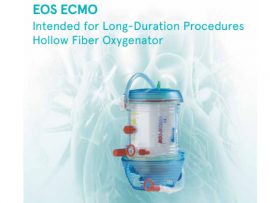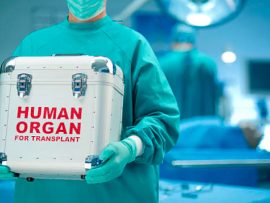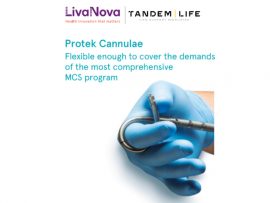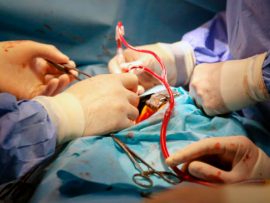Abstract Background The use of Extracorporeal Membrane Oxygenation (ECMO) remains associated with high rates of complications, weaning failure and mortality which can be partly explained by a knowledge gap on..
Lire la suiteAbstract The therapeutic target of extracorporeal carbon dioxide removal (ECCO2R) is the elimination of carbon dioxide (CO2) from the blood across a gas exchange membrane without influencing oxygenation to a clinically relevant..
Lire la suiteAbstract Background Thoracoabdominal normothermic (TA-NRP) has emerged as a powerful technique for optimizing from donation after circulatory death donors. Despite its rapid adoption, standardized guidelines for TA-NRP implementation are lacking, prompting the..
Lire la suiteAbstract Based on a voluntary registry, founded by the German Society for Thoracic and Cardiovascular Surgery (DGTHG) in 1980, a well-defined but limited dataset of all cardiac and vascular surgery..
Lire la suiteAbstract In recent decades, the use of veno-arterial extracorporeal membrane oxygenation (VA-ECMO) has increased. In acute cardiogenic shock, VA-ECMO implantation can serve as a bridging solution to facilitate recovery, provide..
Lire la suiteAbstract Background: Veno-Arterial Extracorporeal membrane oxygenation (VA-ECMO) provides temporary cardiopulmonary support in the setting of refractory cardiogenic shock. Mechanical ventilation and sedation often accompanies VA-ECMO support and carry the increased risk..
Lire la suiteAbstract Terminal heart failure presents challenges, requiring cardiac transplantation, or mechanical circulatory support. Limited donor organ availability has made mechanical support crucial. Advances in centrifugal-flow systems, compared to axial-flow, have..
Lire la suiteAbstract There is insufficient data on the outcomes of donation after circulatory death (DCD) multiorgan transplant that includes heart. The primary objective of this study is to compare the overall..
Lire la suiteAbstract Utilization of 10ºC static storage safely extended both ischemic time and travel radius in heart transplantation. A 57-year-old man with ischemic cardiomyopathy, a left ventricular assist device (LVAD), and..
Lire la suiteAbstract The complement system is a set of over 50 proteins that constitutes an essential part of the innate immune system. Complement system activation involves an organized proteolytic cascade. Overactivation..
Lire la suiteTuscany Normothermic Regional Perfusion Mobile Teams for Controlled Donation After Circulatory Death
Abstract Introduction To facilitate the implementation of controlled donation after circulatory death (cDCD) programs even in hospitals not equipped with a local extracorporeal membrane oxygenation (ECMO) team, some countries have..
Lire la suiteAbstract Objective Bleeding after cardiac surgery leads to poor outcomes. The objective of the study was to build the PeriOperative Bleeding Score in Cardiac surgery (POBS-Card) to predict bleeding after..
Lire la suiteAbstract Data on perioperative extracorporeal membrane oxygenation (ECMO) in liver transplantation (LT) are scarce. ECMO has been used preoperatively, intraoperatively, and postoperatively for a variety of indications at our center...
Lire la suiteAbstract Heart transplantation and left ventricular assist devices (LVADs) have emerged as crucial interventions for end-stage heart failure, dramatically improving patient outcomes. This narrative review examines their historical context, indications,..
Lire la suiteAbstract Patients on left ventricular assist devices (LVAD) are prone to excessive hemostasis disturbances due to permanent contact of artificial pump surfaces with blood components. We aimed to investigate if..
Lire la suiteAbstract Axillary artery intra-aortic balloon pump (axIABP) placement has been implemented as a bridging solution before heart transplantation. This study evaluates complications associated with axIABP support and describes an approach..
Lire la suiteAbstract Background. The pulmonary assist system (PAS) is a wearable respiratory support system that is currently under development for patients with chronic lung disease as a bridge to lung transplantation..
Lire la suiteAbstract Background We sought to characterize the association between venovenous (VV-ECMO) bridging duration and outcomes in patients listed for . Methods A retrospective observational study was conducted using the Organ Procurement and..
Lire la suiteAbstract Purpose of review Although lung transplantation stands as the gold standard curative therapy option for end-stage lung disease, the scarcity of available organs poses a significant challenge in meeting..
Lire la suiteAbstract Heart failure (HF) is a frequent and severe condition. It is estimated that one in four patients will die within a year following hospitalization for acute decompensation, with significant..
Lire la suiteAbstract Venovenous bypass (VVB) is a technique used in liver transplantation (LT) to maintain hemodynamic stability and abdominal organ perfusion and thereby improve patient outcomes. Despite its perceived benefits, VVB..
Lire la suiteAbstract Objective The mismatch between the demand for and supply of organs for transplantation is steadily growing. Various strategies have been incorporated to improve the availability of organs, including organ..
Lire la suiteAbstract Acute myocardial infarction-related cardiogenic shock (AMI-CS) carries a dismal prognosis. Short-term mortality is in the range of 40–50% []. Until recently, only treatment of the culprit lesion by percutaneous..
Lire la suiteAbstract OBJECTIVES Dual-lumen cannulas for veno-venous (VV) extracorporeal membrane oxygenation (ECMO) support are typically inserted in the right internal jugular vein (RIJV); however, some scenarios can make this venous route..
Lire la suiteAbstract Importance Centralizing deceased organ donor management and organ recovery into donor care units (DCUs) may mitigate the critical organ shortage by positively impacting donation and recipient outcomes. Objective To compare donation..
Lire la suiteAbstract Background and Aims: The practice of intraoperative blood salvage and autotransfusion (IBSA) during deceased donor liver transplantation (DDLT) for hepatocellular carcinoma (HCC) can potentially reduce the need for allogeneic..
Lire la suiteAbstract Thoracoabdominal normothermic regional perfusion (TA-NRP) is increasingly implemented in donation after circulatory determination of death (DCD). Thoracoabdominal normothermic regional perfusion allows thoracic and abdominal organs to be perfused with..
Lire la suiteAbstract Introduction Pump-controlled retrograde trial off (PCRTO) is described as an effective weaning strategy for veno-arterial extracorporeal membrane oxygenation (ECMO) in the guidelines. Contrastingly, there is no established weaning strategy..
Lire la suiteAbstract Despite technological advances in left ventricular assist device (LVAD) technology, which have made survival competitive with heart transplantation at 2 years, right ventricular failure (RVF), with an incidence of..
Lire la suiteAbstract Objectives Heart donation after circulatory death was recently reintroduced in the United States with hopes of increasing donor heart availability. We examined its national use and outcomes. Methods The..
Lire la suite















